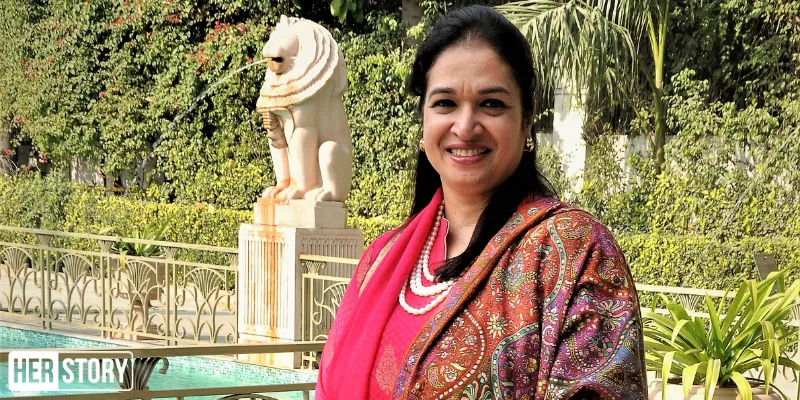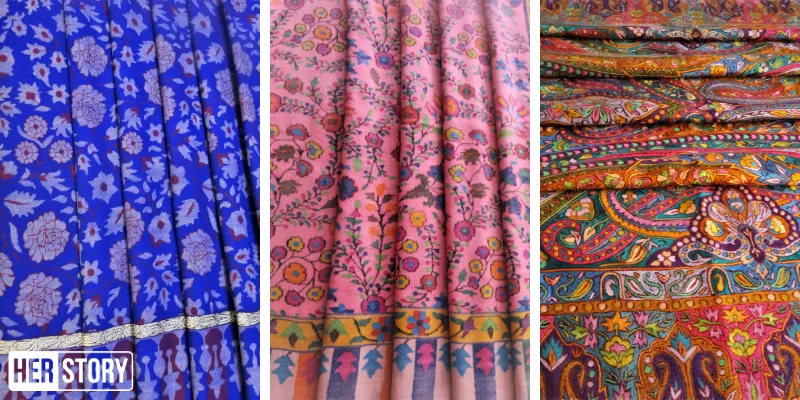This woman entrepreneur took her husband’s dream forward by showcasing traditional Kashmiri shawls
Varuna Anand’s husband was very keen to promote weavers of the famous Kashmiri pashmina shawls from his home state. After his death, Varuna made his dream a reality by starting, The Splendor of Kashmir, which offers a comprehensive range of curated shawls.
When Varuna Anand married Praveen and moved to his hometown in Jammu, she adopted the state and its traditions as her own.
A qualified textile designer, she was very passionate about designing. She designed sarees and later home furnishings, which were exported to Europe. When she got married in 2002, she took a sabbatical from work for nine years to raise her two daughters.

But entrepreneurship runs in Varuna’s genes. Her grandfather was a well-known businessman from Amritsar, and she has vivid memories of a childhood listening to glorious tales of his textile business. She was raised in Delhi and pursued textile designing as a career after completing a three-year diploma from New Delhi Polytechnic.
As a textile designer, she spent many years learning and designing home textiles and sarees for the likes of House of Fraser, John Lewis, Galleries Lafayette Printemps, Laura Ashley, Tommy Hilfiger, and Satya Paul.
An entrepreneur by fate
Fate dealt a hard blow when Praveen passed away in 2012.
“The Splendor of Kashmir was a dream project of my late husband Praveen. He had insisted on starting this for me in 2011 as he was very keen to promote craft from the state as he felt it would benefit people. Also, he had immense faith that I had the ability to market these shawls and take them to the genuine lovers of this art. I don’t think I ever thought of restarting with a career as an entrepreneur, but after his demise, I knew I had to try sincerely and wholeheartedly to take this dream project of his forward,” she says.
Varuna’s only association with shawls until then was that like any other Punjabi household, her mum too had put away Kashmiri shawls for her trousseau.
She invested around Rs 15 lakh and plunged into the business in 2012, offering a comprehensive range of curated shawls. “We like to use classic patterns that have been passed down through centuries to keep the essence of these shawls alive. Our inputs are in terms of colour combinations and designing the less expensive shawls we promote as gifts. For the Classic Jamavar shawls, we use traditional patterns with a test of colour keeping the current market trends in mind,” she adds.
Its Ethereal & Classic collection, also fondly termed the Heirloom Collection, is endorsed and curated by Sara Abdullah Pilot. This is a collection of exclusive Kani shawls and extensively hand-embroidered Jamavar shawls. Keeping up with the market trends, the company is also promoting Kalamkari shawls, which are hand-painted and then hand-embroidered.
Providing locals with work and revenue

Shawl-making is the largest cottage industry of Jammu and Kashmir. A large part of the local population is involved in the making of this craft, and with the promotion of these shawls, Varuna hopes to touch a large number of lives in the region, thereby indirectly providing them with both work and revenue.
“Women are an integral part of this industry,” Varuna says. “The government runs training centres to help them learn the art of Kani shawl weaving, which was a male domain. Today, they are involved in embroidery, spinning, and sorting of the yarn.”
Varuna sells her products online and through exhibitions only. Most of the reach is through social media, especially Facebook and Instagram, through which she can cater to customers in India and abroad.
Shawls from Kashmir have a rich history – they were used by the royals and are known as a luxury commodity. The Splendour of Kashmir has a niche clientele, so the products are expensive.
As a new entrepreneur, Varuna faced a fair share of challenges.
“I was very insecure about my ability to carry on with this venture and would fear every step I took. I was basically sheltered a lot by my husband and never felt that I could carry this venture forward without his support. My greatest high came when my work was acknowledged by connoisseurs of this art and I won the outstanding woman entrepreneur award by a large media group.”
“I believe the future of our success lies in reaching out to more people. Since our module of selling is through exhibitions and online media, we must reach out to more cities and people, and prepare to be part of exclusive events globally,” Varuna says.
(Edited by Teja Lele Desai)









